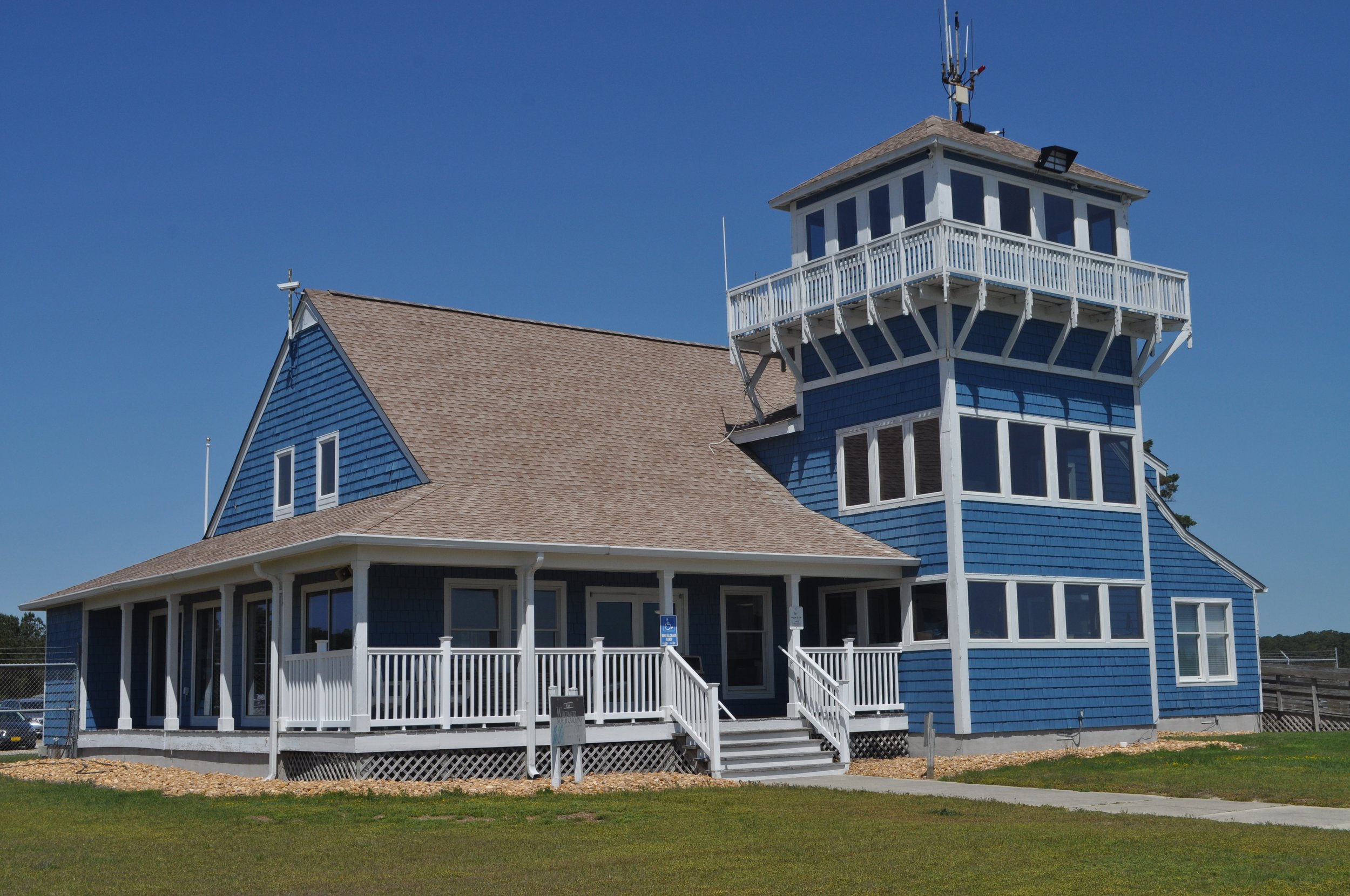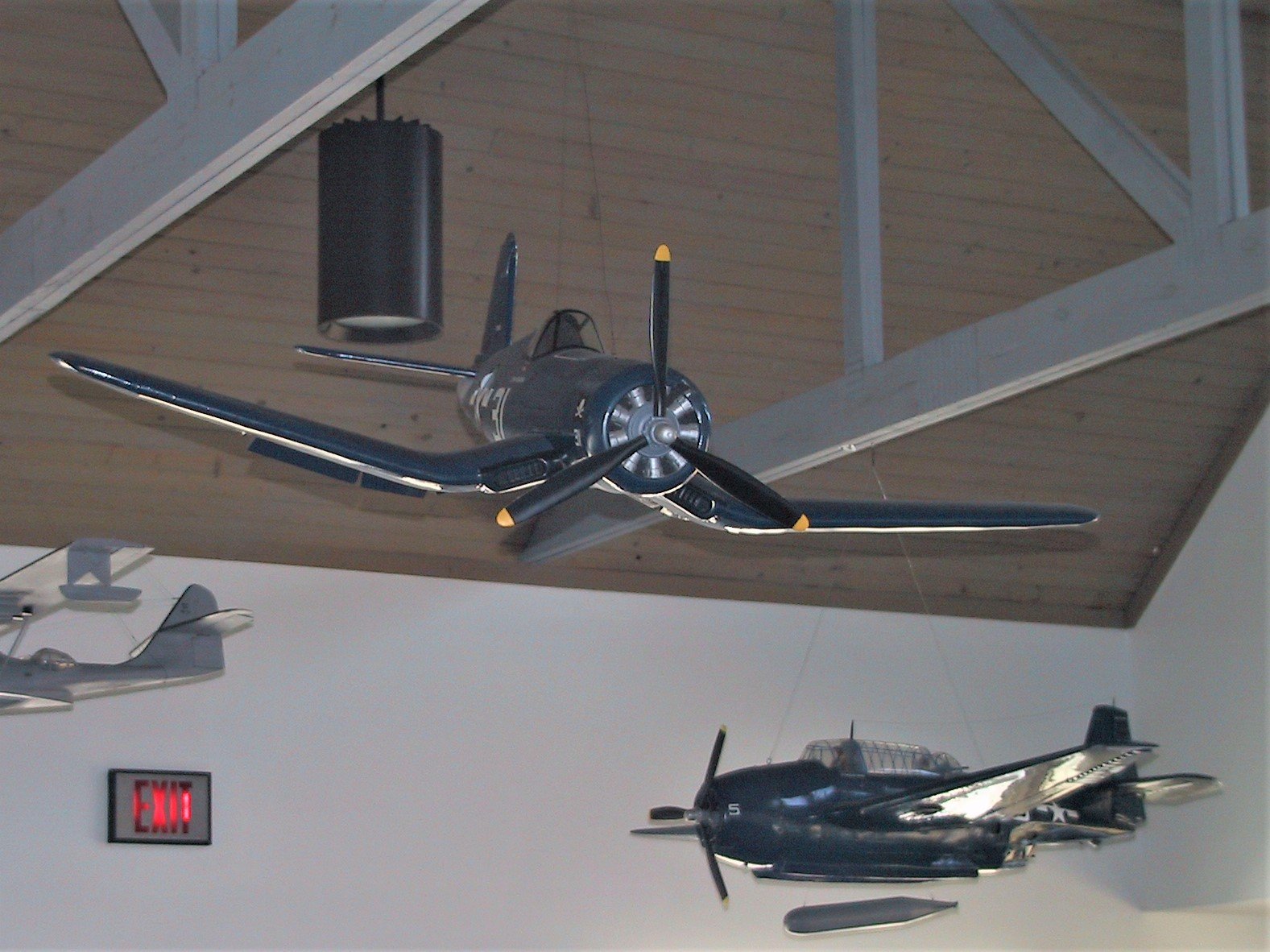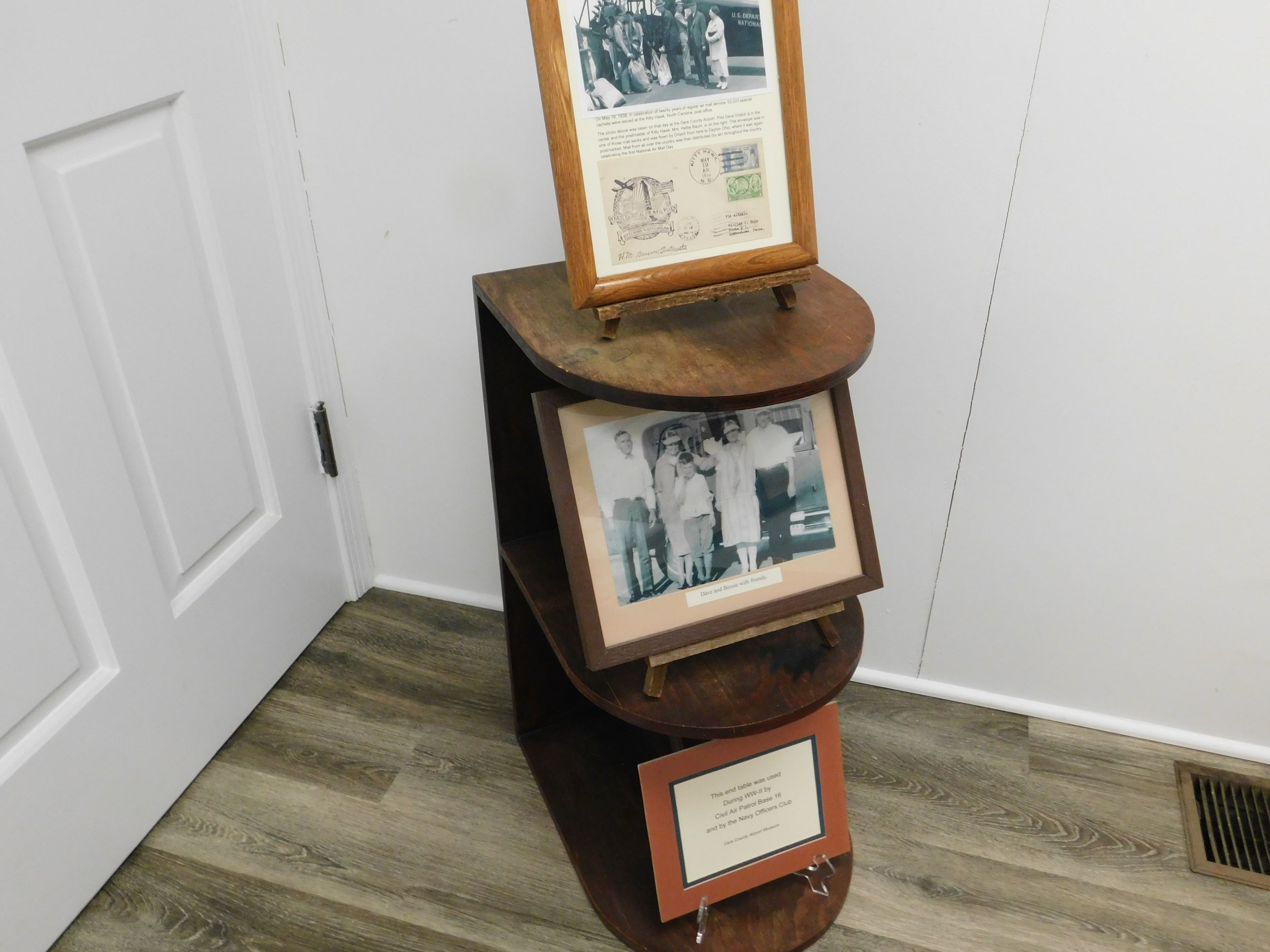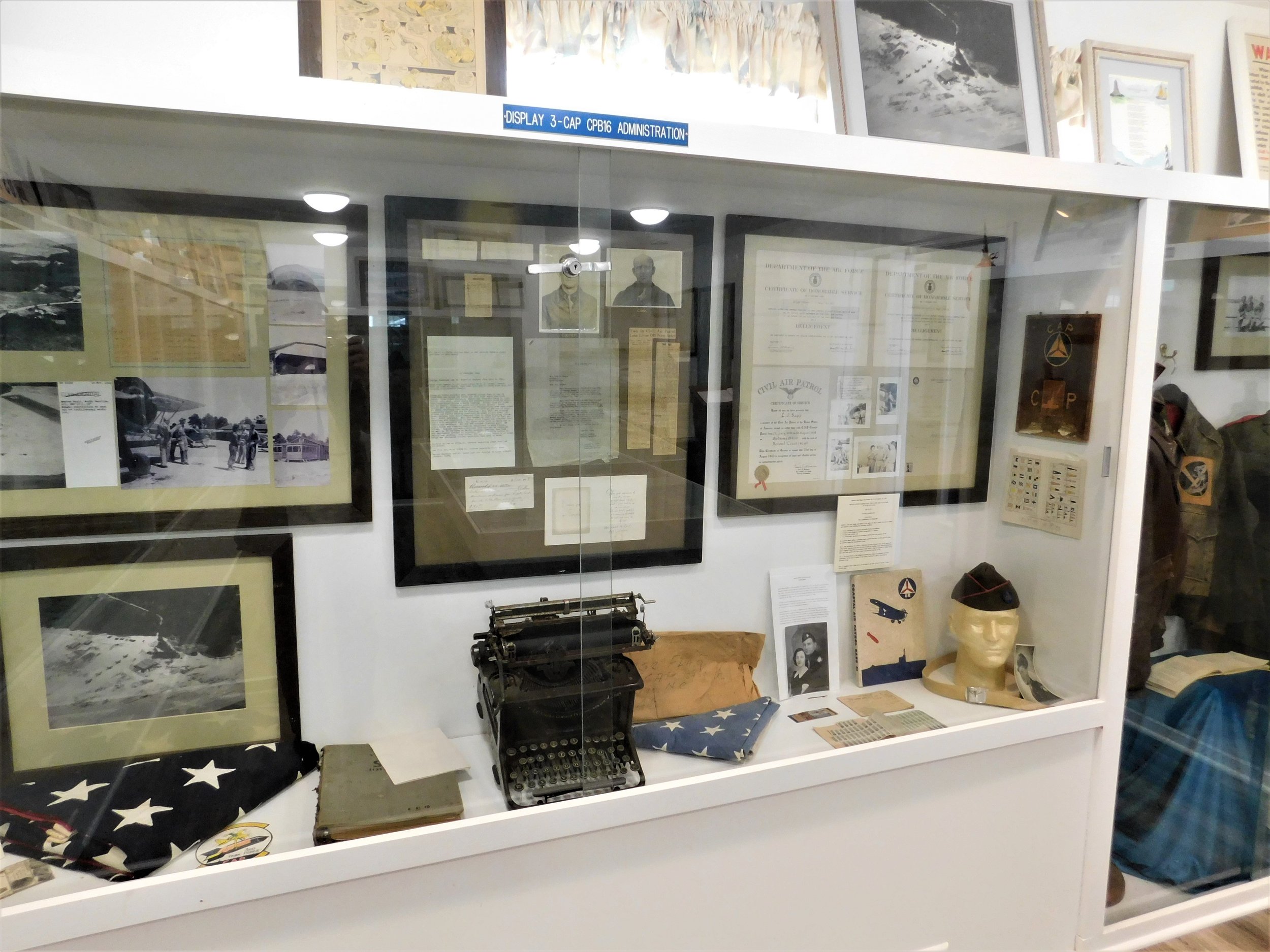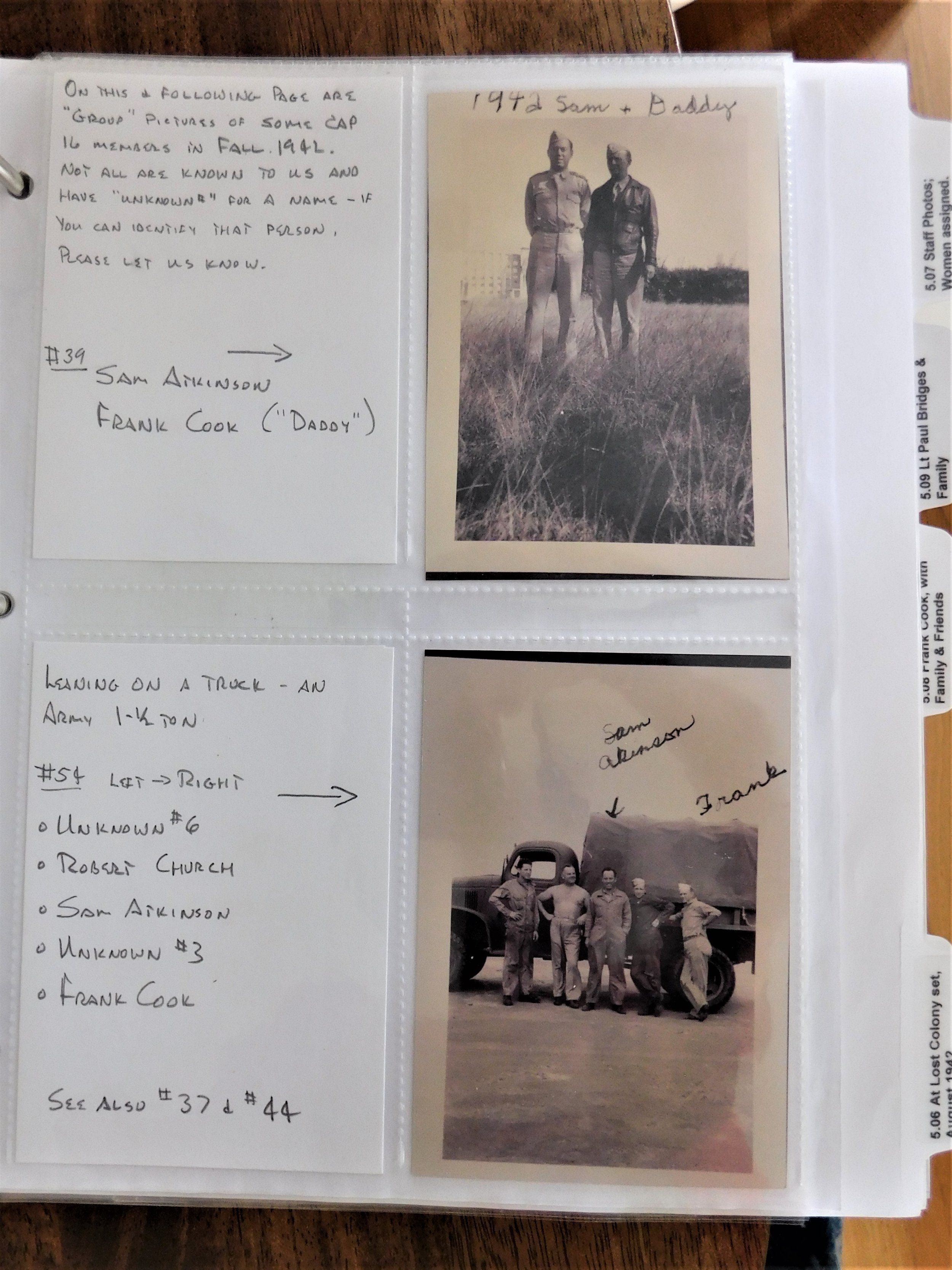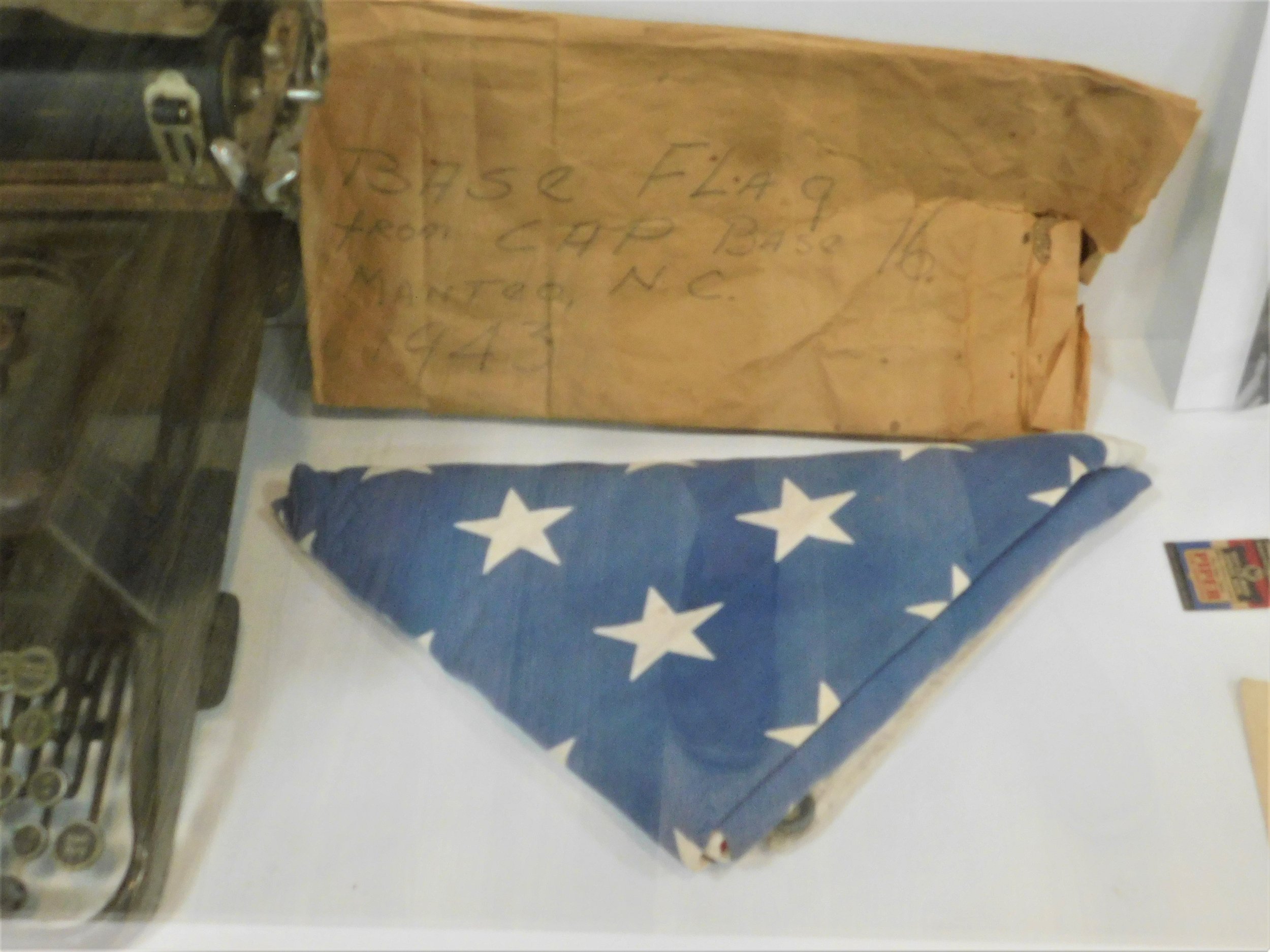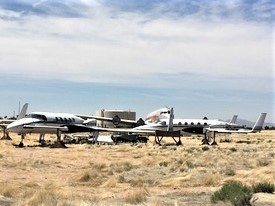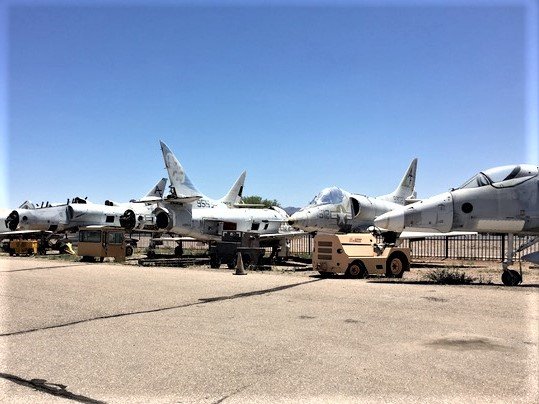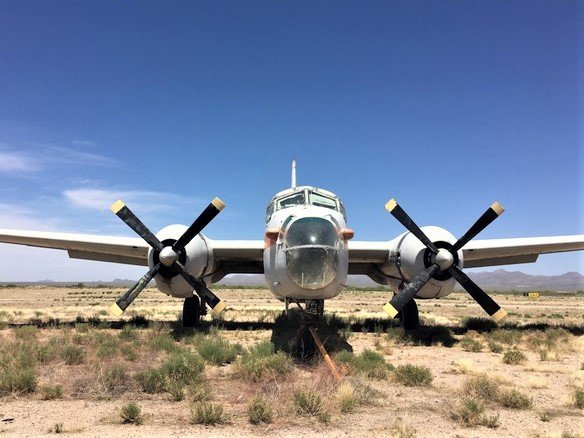Dare County Airport Museum
Part 1
Issue 36 A visit to the Dare County Airport Museum, Manteo North Carolina
On 27 July 1942, a number of civilian pilots departed Charlotte, Ashville, Winston Salem, and other North Carolina cities and towns flying their own small planes. They were bound for Skyco Field on Roanoke Island on the Outer Banks of North Carolina.
Skyco Field
Once established at Skyco, the pilots, part of the newly formed Civil Air Patrol, began flying missions off the North Carolina coast looking for German U-Boats, a vital task that the military was not yet equipped to do. Before flying the missions, they set up temporary quarters to serve as barracks and administration buildings. They also organized supplies for all the tasks required to support an air base, such as fuel trucks, maintenance supplies, and radio equipment.
The first page of the CAP Journal that is on display at the Dare County Airport Museum
A CAP Stinson Reliant arriving at Skyco field.
The Dare County Airport Museum (DCAM) was opened in 1992, to celebrate the 50th anniversary of the opening of the airport. Located in the terminal, the museum occupies two display rooms as well as having a number of aircraft models displayed from the ceiling of the main lobby.
DCAM has three eras on display: The main display room tells the story of the Civil Air Patrol and the U.S. Navy at Dare County Airport, and a second room honors Dave Driskill. The years that are covered in the Operations/Driskill Room nicely bookend the museum’s CAP and Navy history. Driskill was a major force in developing aviation on the Outer Banks in the 1930s, setting the stage for operations during World War II. He spent most of the war years away from North Carolina, but returned in 1946 to become the first airport manager when Dare County took over the airport.
The museum was founded in 1992 by several people, most notably Harry Bridges, who is largely responsible for the museum as it is today. The early developers gathered materials directly related to operations at the airport. The various display cabinets (other than one rotating display) are totally devoted to exhibiting items that were actually used at the airport during WW-II. There are also a number of well-organized binders that contain a wide variety of documents and photographs from the era.
The museum covers the subjects in great depth and this issue will be part 1, the pre-war years, and the tenure of the Civil Air Patrol at Skyco and Dare County Airports. The Navy arrived in 1943 and that era, plus the post-war years, will be presented in a future issue.
Let’s begin with a look at the career of Dave Driskill, who was the driving force in developing aviation on the Outer Banks in the 1930s. His life is thoroughly covered in its own display room- aptly called the “Driskill Room”.
John David Driskill was born in Tennessee in 1897. He moved to South Carolina in 1914 to work as an apprentice auto mechanic. Driskill spent a short time in the Army at the very end of WW-I and remained in Virginia to open his own auto repair company. He sold the business in 1925, but stayed in the Hampton Roads area, working as an auto mechanic. He also worked part time as an aircraft mechanic for barnstormer Jimmy Crane. One day in 1926, when Crane was away from the field, Driskill started up Crane’s war surplus Curtiss JN-4 Jenny. It didn’t take long for Dave to decide to taxi around a bit. Eventually, he let the plane lift off and he flew around the area, thus becoming one of the last pilots to literally teach himself to fly.
The Driskill room contains a number of framed displays that illustrate the career of Dave Driskill with photographs, newspaper articles, and documents.
Driskill immediately became hooked on aviation and started taking formal lessons. During the next few years, he held a variety of positions as a mechanic and pilot, and he continued this Jack-of-all-Trades philosophy throughout his career. He was a barnstormer as well as an entrepreneur and promoter. These attributes led him into various positions, including promoter (and pilot) for airshows. He was, by all reports, an excellent pilot.
Dave Driskill delivering Santa. Norfolk VA, circa 1927
In 1930, Driskill was hired by industrialist George Lyon as his personal pilot. Lyon invented and manufactured car bumpers and, like Driskill, he had wide ranging skills and interests. He was an avid sportsman and hunter and he had built a hunting lodge on Hatteras Island on the Outer Banks. Flying Lyon and his friends to the lodge in a Bellanca, Driskill saw the potential for aviation in this remote area. During this time Driskill became familiar with the vagaries of the weather on the Outer Banks as well as the phenomenon of shifting sands. He developed knowledge of different places on the Outer Banks that were suitable to land an airplane.
In 1932, in the depths of the depression, Driskill lost his job with Lyon. In 1933 Franklin Roosevelt became president and the Civil Works Administration (CWA) was formed. Driskill was hired as an airport inspector for the CWA, but, true to his personality, at the same time he helped found Witch Duck Airplane Lines in Norfolk. The airline operated two scheduled daily flights across the mouth of Chesapeake Bay to Cape Charles. By 1935, Driskill was working as a maintenance supervisor at Fort Eustis, VA. Around this time, the Works Progress Administration (WPA) took over Fort Eustis, and it became the largest depression relief camp in the country. Driskill served in a variety of roles at the camp, mainly as an instructor in a number of disciplines.
In 1934, a Civilian Conservation Corps (CCC) base was established on the Outer Banks and, along with the CWA and the WPA, they began working to stabilize the drifting sands of the Outer Banks. Thousands of men were camped all along the Outer Banks working on the project, which would eventually become the Cape Hatteras National Seashore. Dave Driskill, with his experience flying to the beaches of the Outer Banks, began flying supplies, personnel, and mail from Fort Eustis to Cape Hatteras and other spots on the Outer Banks.
Dave was always interested in establishing regular air service to the Outer Banks and during this time he was also co-founder, and pilot, for the Roanoke Island Flying Service. This 1938 article from the Dare County Times illustrates the skeptical public perception of commercial flying at the time. The headline reads- “Thirty Days of Flying and no Funerals yet”.
Dave Driskill delivering supplies to Cape Hatteras circa 1939
By 1936, Driskill was also flying for the National Park Service (NPS). The service acquired a Fairchild FC-2W2, the plane pictured above, and Driskill became the primary pilot in the area. That particular Fairchild has had a long and interesting career, and it is still flying today.
Sherman M. Fairchild was a businessman and inventor and, much like Dave Driskill, his interests were wide ranging. While in college, he invented the first synchronized camera and flash. He was medically ineligible for service in WW-I, but he decided to help the war effort by developing and improving aerial cameras. In 1920, he established The Fairchild Aerial Camera Corporation and the Army selected his camera for military use (during WW-II, over 90% of the aerial cameras used by the Allies were designed and built by the Fairchild Corporation).
Fairchild was a true entrepreneur and he developed his businesses in many directions. His photography business received a number of contracts for aerial mapping and he tested several existing aircraft for that purpose. Finding them all lacking, he went to various aircraft manufacturers with specifications for a purpose-built photo plane. Unable to find a satisfactory bid, he decided to build his own plane.
Model of Fairchild FC-2W2 displayed in the lobby of the Dare County Airport Museum
The prototype Fairchild FC-1 first flew in 1926. An upgraded version, the FC-1A, went into production as the FC-2. A number of versions of this plane were built, eventually totaling about 180. The Fairchild was adaptable for many applications including military, airline, and even float plane use. Two of the planes became famous. One participated in a record-setting around the world flight and another, named Stars and Stripes, an FC-2W2, was taken by Richard Byrd on his Antarctic expedition of 1928.
In November of 1928, FC-2W2, serial number 531, was completed and delivered to the National Advisory Committee for Aeronautics (NACA), the predecessor of NASA. NACA used the plane for general transportation service but also found it adaptable for research. It was fitted with de-icing equipment for testing and was also used for drag research. By 1936, NACA no longer needed the Fairchild and it was transferred to the National Park Service. Dave Driskill became its primary pilot, and it was used for a variety of missions including aerial survey.
FC-2W2 – N13934 today. Photo courtesy of the Golden Wings Museum
During the winter of 1936, snow blanketed the Outer Banks and the Pamlico Sound froze over. In addition, the wooden Wright Memorial Bridge (built in 1930) partially collapsed due to ice build-up. The Fairchild, with Driskill as the pilot, proved invaluable in carrying supplies, mail, and medical service to the thousands of stranded workers on the Outer Banks.
In the summer of 1937, Driskill found a location in the village of Skyco on Roanoke Island to set up a more permanent landing field on the Outer Banks. This field, on the farm of the Midgette Family, set the stage for the arrival of the Civil Air Patrol during WW-II.
The story of Dave Driskill includes many events and it is interestingly told as visitors follow his career in well laid-out displays. The Driskill room also has three original artifacts from the World War II era of the Dare County Airport.
The simple work table was used in the airport operations room for many years. The desk in the foreground is “Dave’s Desk” used by Dave Driskill throughout his years at the Dare County Airport.
The small end table was used by the Civil Air Patrol and the US Navy during the war.
One of the photos on the end table depicts the inaugural celebration of Air Mail Week on 19 May 1938. Dave Driskill is in the middle, closest to the cockpit. The lady on the right is Hettie Baum, the Kitty Hawk postmaster. On that day, letters were flown from Kitty Hawk to Dayton, OH, home of the Wright Brothers, and then on to Washington DC. From Washington they were routed on to their final destination.
On display is one of the letters that made the journey that day. It was in one of the bags in the photo and it has Kitty Hawk and Dayton (on the back) postmarks.
Dave’s Desk
By 1941, the National Park Service had purchased a Kellett Gyrocopter for aerial surveying and general transportation. Dave Driskill flew the Kellett, which was manufactured in Philadelphia, and he became a proponent of the use of gyrocopters. This began a relationship with the Kellett Corporation, and Driskill eventually became one of their test pilots. Driskill also became the first pilot to earn a helicopter rating on his FAA license.
After WW-II, at the same time as running the Dare County Airport, Dave Driskill continued as a test pilot for Kellett. This relationship led to his tragic end, a story we will tell later, in Part Two
————————————————————
The story in the museum now turns to the arrival of the Civil Air Patrol on the Outer Banks. There had been a recognition in the mid-1930s of the possibility of mobilizing civilian aircraft for civil defense and the Civil Air Patrol was authorized at the end of 1941, just days before the Pearl Harbor attack.
The newly activated North Carolina wing of the Civil Air Patrol flew its first patrol mission out of Skyco on 10 August 1942. The field that Dave Driskill developed with an eye to starting scheduled air service to the Outer Banks was an ideal temporary location for the CAP. They would not have been able to start operations in August without it, as the new airport in Manteo was not yet useable. The Dare County Airport had been planned since the mid-1930s, with the hope of developing tourism. With war clouds forming, the War Department finally authorized building the airport in 1940, with the agreement to eventually turn it over to Dare County.
The mission of CAP Base 16 was coastal patrol, protecting shipping lanes, and providing watch for enemy ships as well as allied shipping. The small aircraft were not fully armed, but the mere presence of planes in the air went a long way to deter U-Boat activity. The missions were all flown by a two-man crew of pilot and observer and Patrol Base 16 operated from dawn to dusk in the area between Norfolk and Ocracoke Island.
The Dare County Airport Museum has a number of wonderful original photos of the Civil Air Patrol at Skyco. Today they are mainly displayed in a binder, but there will be a larger display about Skyco in the near future.
Fueling a Stinson Voyager at Skyco
By October 1942, the new airport on the north end of Roanoke Island was available for use. To keep operations continuing, the CAP transferred to the newly opened airport in Manteo over a period of several months.
CAP Base 16, Manteo NC, 1942
As you enter the main display room, you will find Civil Air Patrol items displayed in the cases to the right.
The first cabinet contains a variety of uniforms worn by CAP personnel. These uniforms are the actual uniforms worn by members who served at CAP Base 16 here in Manteo. Donated for display by the CAP members themselves, or their families, each display recognizes the person who worked here and wore the uniform. Although more closely aligned to the Navy, as the main mission was coastal patrol, the CAP was loosely an Army organization, and members wore Army style uniforms and insignia. (Today the Civil Air Patrol, with 56,000 members, is an auxiliary of the U.S. Air Force. Its mission is to search for and find the lost, provide comfort in times of disaster, and work to keep the homeland safe).
The most interesting aspect of this museum is the collection of original documents, artifacts, and photographs. Some of these items are framed and described in the display cases, while others are in very well-organized binders. One of the binders contains the entire operations journal of the Civil Air Patrol Base 16- at Skyco and Manteo. The pages of the journal were typed on the typewriter displayed above and it makes very interesting reading. Visitors can page through random entries or sit and read a detailed account of daily operations at Manteo Airport during the early part of World War II.
CAP Base 16, Manteo NC, 1943
One group of items on display are personal items of 1st Lt. William P. Bridges, the father of museum founder Harry Bridges. The display honors the service of Lt. Bridges and includes his log book and the Air Medal that he was awarded for meritorious achievement and exceptional courage.
Meticulously organized and notated, the collection of binders makes fascinating reading. One binder contains photos of many of the CAP personnel who were stationed here, and many more of every day events at the base and on Roanoke Island. Each is captioned with a variety of information.
As referenced earlier, this binder has the complete operations journal of CAP Base 16. Most of the entries are everyday events and mundane occurrences, but not all of them.
On the afternoon of 21 December 1942, a Stinson 10A, NC36782, along with a second aircraft, departed Manteo on a routine patrol. Just before dark, the Stinson, piloted by Lt. Julien L. Cooper along with observer Lt. Frank M. Cook, reported a sudden loss of power. They were observed hitting the ocean, and both men got out and into their lifeboat. In the display case in the center of the main room there is a vivid description of the unsuccessful attempt to rescue the two men in the gathering darkness and heavy surf.
From the entries in the base S-2 journal, we can see that all hands participated in the search for the two men. The plane accompanying Cooper and Cook, as well as two other search planes made forced landings on the beach after running low on fuel.
Three months later, the body of Lt. Cook was spotted in the ocean just north of Cape Lookout and was recovered by the Coast Guard. The remains of Lt. Cooper were never found.
The central display case honors the two CAP flyers.
By the summer of 1943, the Navy had built enough resources to take over coastal patrols and the need for the Civil Air Patrol to provide that service ended. On August 31 1943, the flag that had flown over Coastal Patrol Base 16 since it opened was lowered for the last time. That flag is on display in the museum.
In December 1943, the CAP personnel stationed at Manteo were combined with the personnel from CAP Base 21 in Beaufort, NC and transferred to NAAS Driver, VA. The two units formed Civil Air Patrol 21 Tow Target Unit. They continued to serve in that capacity until the end of the war.
The Dare County Airport Museum does an excellent job of telling the story and preserving the memory of this largely unheralded group of pilots and ground crew who served in the Civil Air Patrol. As historian Lt. Col (CAP) Frank Blazich wrote in Air Power History Magazine (Spring 2019)-
“For eighteen months, civilian volunteers flew privately-owned civilian aircraft over the Atlantic Ocean and Gulf of Mexico in defense of the United States. With a minimum of funding from the federal government, private industry, and often the wallets of the volunteers themselves, CAP’s coastal patrol service provided a stopgap measure when the nation’s armed forces lacked the assets to deter and constrain enemy submarine operations”.
The Dare County Airport Museum is a unique place and should not be missed when you visit the Outer Banks.
DCAM covers aviation history on the Outer Banks other than the Wright Brothers. That history is well presented by the National Park Service at the Wright Memorial which was covered in Issues 6 & 7 of this blog.
---------------------------------------------------------
Although there were a number of participants in putting together the Dare County Airport Museum, Harry Bridges was the driving force and is mainly responsible for the museum as it is today. John Ratzenberger, who took over as museum curator after Harry, put it this way “Harry was around forever, knew everyone, didn’t take much to get someone involved - don’t want to minimize any of them. It was like a barn raising. You & I, as non-locals could never have done it. And Harry, through his dad, had the CAP covered.” John also deserves a lot of credit for keeping the museum going, as well as upgrading the various binders. John also produced and narrated a video which eloquently tells the story of the airport and the museum. It is available for viewing in the museum.
https://www.darenc.com/departments/airport/museum
I have often noted in this series that it is the work and dedication of people like Harry Bridges and John Ratzenberger who have preserved history for us and future generations. We owe them many thanks. As the current curator, I have big shoes to fill to maintain this great museum.
A special mention also for Stacy Ambrose and his staff at the airport. They not only keep the airport facility running smoothly but they open and close the museum each day and ensure that it stays neat and clean. Thanks everyone!
Note- I took over as curator of the museum earlier this year and I am still learning about all the great artifacts in the collection. The vast amount of material available is what made it harder than usual to write this blog- but it certainly was enjoyable.
---------------------------------------
To learn about what to do in the local area, museum hours and costs as well as books to read and other interesting odds and ends, keep reading! At the end you will find a photo gallery of the entire museum.
PLANNING YOUR VISIT
The museum is in the terminal of the Dare County Airport and is open daily from 8 AM to 7 PM. Admission is free.
FLYING IN
Dare County Regional Airport (KMQI) has two runways 05/23 (4300’) and 17/35 (3300’). There are RNAV approaches to 05, 17, and 23. The FBO is in the main terminal with full fuel service as well as rental cars. In the summer, there is a temporary FAA tower. There are a wide variety of activities on the field including banner tow and sky diving.
LOCAL ATTRACTIONS
There is obviously a lot to do and see on the Outer Banks. When visiting the Museum on Roanoke Island, you can also visit the North Carolina Aquarium (right next to the airport), Fort Raleigh National Historic site, and Island Farm. The town of Manteo has many shops and restaurants and is right on the waterfront. Olives (Greek) and Ortega’s (Mexican) are great places to eat and Downtown Books is a great bookstore.
The history of shipping along the treacherous Outer Banks is told by The Graveyard of the Atlantic Museum in Hatteras. It is an excellent museum that has a lot of information about U-Boat operations off the North Carolina Coast and artifacts from U-Boats that were sunk there.
https://graveyardoftheatlantic.com/
If you are interested in something a little different, visit Kitty Hawk Kites at Jockey Ridge State Park (15 minutes from the airport). If wind conditions are right, you can fly an exact replica of the 1902 glider that the Wright Brothers flew in Kitty Hawk. You get a ground school session and five flights and it is a truly unique experience.
https://www.kittyhawk.com/adventures/1902-wright-glider-experience/
Your author doing his best Wilbur Wright impression on the replica 1902 Wright Flyer
WHERE TO EAT
Besides the two restaurants above, I recommend Blue Water at Pirate’s Cove. Great seafood with a view of the fishing marina (10 minutes from the airport).
SUGGESTED READING
I was recently asked to review a book, The Turtle and the Dreamboat for an on-line publication. Written by Jim Leeke, it is about two long-range flights just after WW-II, one by the Navy and one by the Air Force. The author writes about all the events surrounding the two flights and it is a great read. See the full review here: https://www.thecipherbrief.com/column/book-review/the-turtle-and-the-dreamboat
Col. Frank Blazich, whom I quoted earlier, wrote an excellent book about the Civil Air Patrol: An Honorable Place in American Air Power. Complimentary copies are available at the museum.
MUSEUM WEBSITE
https://www.darenc.com/departments/airport/museum
UP NEXT
The Cradle of Aviation Museum at Garden City on Long Island, NY
MUSEUMS ARE WHERE YOU FIND THEM
This segment is dedicated to finding interesting aviation artifacts that are in public view- but not in an aviation museum. If you see one send a photo!
My brother Mike recently flew into Marana Regional Airport (KAVQ) and sent these photos and comments.
“The airport was first opened in 1943, as a US Army Auxiliary airfield, and is now considered a relief airport for General Aviation operations in the Tucson AZ area. The airport has a lot of GA activity and the popular Sky Rider Coffee Shop. Located Northwest of the Tucson Bravo airspace, I found it a convenient fuel and overnight stop.
As is typical for desert airports, several interesting aircraft have been retired there. They are located on various parts of the airport, and you can walk right up to all of them. Here’s some of the planes-
DC-4 (C-54)s/ Pratt and Whitney R- 2000 engines
Beech Starships (I thought they were all bought back by Beech!?)
USNavy/USMC A-4 Skyhawks
US Navy F-8 Crusader
US Navy P2V Neptune
There are also various ground support vehicles and equipment. It is definitely worth having a bite at the cafe and wandering around looking at airplanes. The Tucson Aeroservice Center FBO folks were very friendly, and offered me a ride around the field.” All photos in this section courtesy of Mike Bruno. Thanks Mike!
Issue 36, Copyright©2022, Pilot House Publishing, LLC. all rights reserved. Except where noted, all photos by the author
